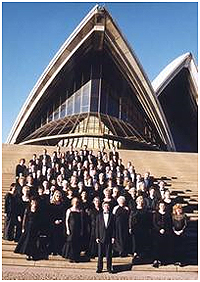genre family: Choral Music
 The voice, of course, is the most natural of instruments. It is the only one capable of conveying both music and text, and thus it has played an essential role in the history of Western art music. Indeed, until the 17th century, the voice was the dominant medium of composition and performance in Europe, with purely instrumental music gaining an equal status only in the mid-Baroque era. Most of the primary musical developments of Western art music – mode, rhythm, counterpoint, and harmony – took place through advances in purely vocal composition during the Medieval, Renaissance, and early Baroque eras, in genres such as (Gregorian) chant, the motet, the Mass, the chanson, and the madrigal.
The voice, of course, is the most natural of instruments. It is the only one capable of conveying both music and text, and thus it has played an essential role in the history of Western art music. Indeed, until the 17th century, the voice was the dominant medium of composition and performance in Europe, with purely instrumental music gaining an equal status only in the mid-Baroque era. Most of the primary musical developments of Western art music – mode, rhythm, counterpoint, and harmony – took place through advances in purely vocal composition during the Medieval, Renaissance, and early Baroque eras, in genres such as (Gregorian) chant, the motet, the Mass, the chanson, and the madrigal.
As the origins of Western art music arose from the communal observances of the Catholic Church, it may be said that a vast majority of all music created in the early Medieval era was choral or ensemble vocal music, as opposed to solo vocal music and especially instrumental music, as noted above. Liturgical chant – most famously Gregorian – was primarily conceived to be performed by a group of trained ecclesiastical singers in unison (monophony), in some cases in alternation with a primary cantor soloist (responsorial singing); this is the case as well for later additions to the liturgical chant repertory (from the 11th century), such as the sequences of Hildegard von Bingen. The subsequent musical developments of the later Medieval period – most notably the inception of polyphony (2 or more melodies simultaneously) – began as embellishments of chant, eventually becoming self-contained genres, notably organum (e.g., of Léonin and Pérotin) and the motet, and were invariably intended for performance by a chorus or ensemble of singers. While some late-Medieval genres, such as the chanson, were conceived for solo singer with instrumental accompaniment, the principal sacred genres – namely, the motet and polyphonic settings of the Mass (e.g., the first cyclic Messe de Nostre Dame by Guillaume de Machaut) – were intended for performance by a chorus or ensemble of trained singers.
The trend for choral or ensemble singing became even more dominant during the Renaissance, as nearly every genre – motets, Mass cycles, chansons, madrigals, etc. – was written for choral forces; indeed, the principal compositional approach used in these genres – equal, related voices in polyphony – required multiple singers (with one or more on an individual part) to perform. That the greatest courts and cathedrals competed with each other for the largest and best choirs (often engaging in nefarious techniques to obtain prized singers) is merely further evidence. The great masterworks of the Renaissance – by composers such as Guillaume Dufay, Johannes Ockeghem, Josquin des Prés, Nicolas Gombert, Adrian Willaert, Orlande de Lassus, Giovanni Pierluigi da Palestrina, Tomàs Luis de Victoria, William Byrd, etc. – were almost exclusively written for choral or ensemble forces, whether sacred (Latin) or secular (vernacular); as such, the Renaissance is often called the “Golden Era” of choral music.
In the early Baroque (around 1600), an effort to mimic the dramas of ancient Greece gave rise to opera, and soon its religious counterparts, the oratorio and the cantata – all of which placed a new emphasis on the power of the solo voice to communicate thought and emotion. These genres frequently combined choral and solo vocal writing, often in alternating movements – culminating in the large-scale cantatas and oratorios by late-Baroque composers such as J.S. Bach and George Frideric Handel – though purely choral works gradually took on a lesser status, and became increasingly associated with sacred music. This pattern continued in the Classical and Romantic periods, where purely choral works are relatively rare and predominantly sacred – which is not to say that superb examples of choral writing are lacking in the vocal output of masters such as Wolfgang Amadeus Mozart (e.g., the Requiem Mass), Franz Joseph Haydn (e.g., The Creation), Ludwig van Beethoven (e.g., the Missa solemnis), Johannes Brahms (e.g., German Requiem), Anton Bruckner (e.g, various Mass cycles), Giuseppe Verdi (e.g., Requiem Mass), and Gustav Mahler (e.g., Symphony No.8). At the same time, many late-Romantic era composers from outside the Franco-German sphere – such as Edvard Grieg, Jean Sibelius, Leoš Janáček, and Pyotr Tchaikovsky – chose to express their national pride by setting folk and sacred texts in their native languages for chorus. The Modern and Contemporary periods have generally maintained the same trend, with some composers – such as Carl Orff, Zoltán Kodály, Benjamin Britten, Ralph Vaughan-Williams, Arvo Pärt, and John Rutter – placing considerable import on choral music within their overall oeuvre.

Nolan Gasser, PhD
Artistic Director













